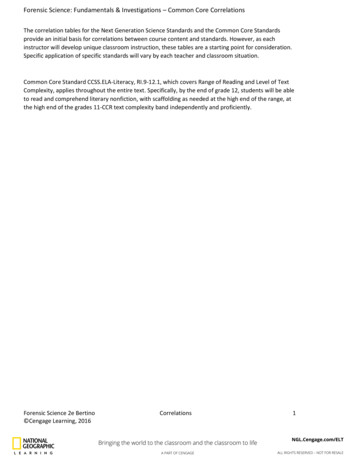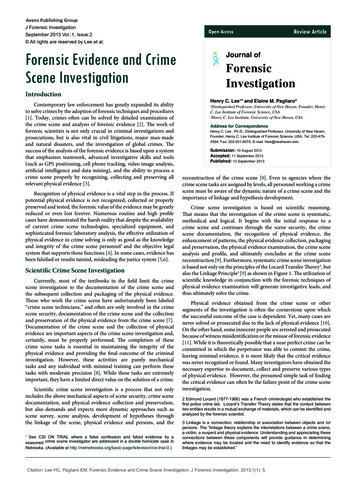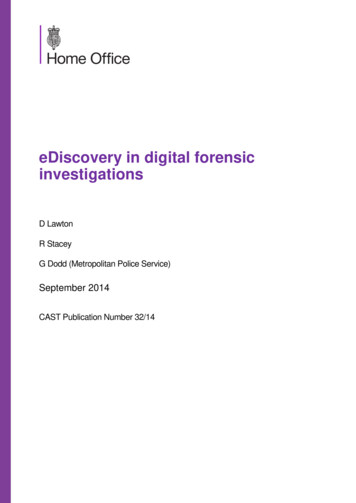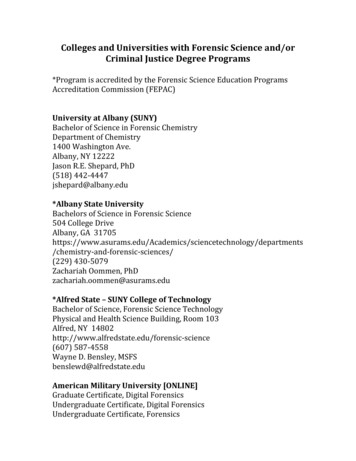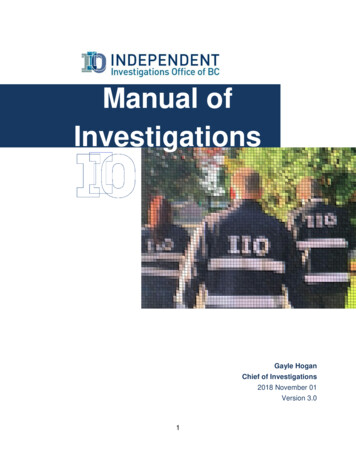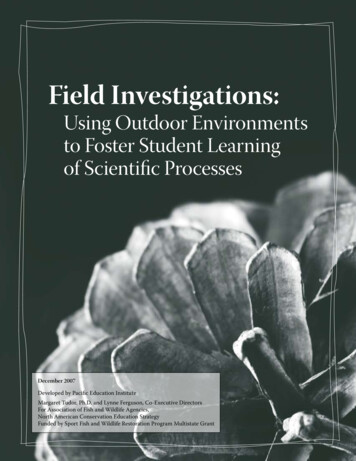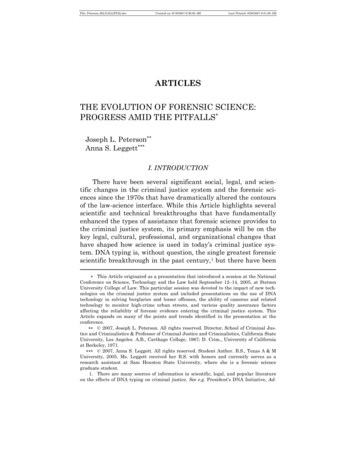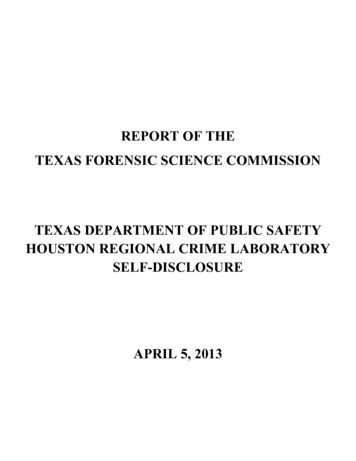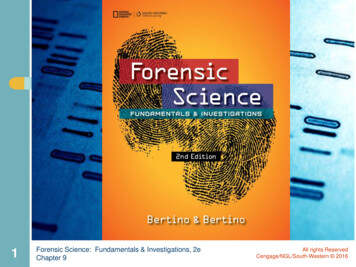
Transcription
1Forensic Science: Fundamentals & Investigations, 2eChapter 9All rights ReservedCengage/NGL/South-Western 2016
Chapter 9 Forensic ToxicologyBy the end of this chapter you will be able to:9.1 Provide examples of drugs, poisons,and toxins.9.2 List factors that affect drug toxicity.9.3 Describe the role of a toxicologist inanalyzing substance evidence.9.4 Compare and contrast presumptivetesting and confirmatory testing.2Forensic Science: Fundamentals & Investigations, 2eChapter 9All rights ReservedCengage/NGL/South-Western 2016
Chapter 9 Forensic ToxicologyBy the end of this chapter you will be able to:9.5 Describe how people get exposed toenvironmental toxins (e.g., pesticides, carbonmonoxide), and describe their effects on the body.9.6 Distinguish among the terms tolerance,addiction, dependence, and withdrawal.9.7 Relate the signs and symptoms of overdosewith a specific substance or combination ofsubstances.9.8 Show the relationships between the law,crime, and the use of drugs.3Forensic Science: Fundamentals & Investigations, 2eChapter 9All rights ReservedCengage/NGL/South-Western 2016
Chapter 9Vocabularyooooooo4addictioncontrolled substanceControlledSubstances Actdependencydepressanthallucinogenillegal drugoooooooForensic Science: Fundamentals & Investigations, 2eChapter ytoxinAll rights ReservedCengage/NGL/South-Western 2016
IntroductionoToxicology is the study of substances that canharm a person. oA person may be exposed to a substance inany of the ways below: 5PoisonsToxinsIntentionallyAccidentallyThe only way toxicologywould come into play in theworkplace is through drugtesting.Forensic Science: Fundamentals & Investigations, 2eChapter 9All rights ReservedCengage/NGL/South-Western 2016
Brief History of ForensicToxicologyoooo6Socrates is one of the earliest reportedvictims of poisoning (Hemlock, 399 B.C.)By the 1600s, poisoning had become aprofession.During the 1800s, methods of chemicalanalysis were developed to identify poisons.In 1980, standardized techniques and testingwere developed to help determine the causeof death.Forensic Science: Fundamentals & Investigations, 2eChapter 9All rights ReservedCengage/NGL/South-Western 2016
Brief History of ForensicToxicology (continued)oooo7In 1959, the FDA was formed.In 1970, Congress passed the ControlledSubstances Act.Today, less than one-half of one percent ofall homicides result from poisoning.Mathieu Orfila is known as the father oftoxicology. (1787-1853)Forensic Science: Fundamentals & Investigations, 2eChapter 9All rights ReservedCengage/NGL/South-Western 2016
Brief History of ForensicToxicology (continued)o8In 1978, Bulgariandissident GeorgiMarkov wasstabbed in the legwith an umbrellaarmed with a ricintoxin.Forensic Science: Fundamentals & Investigations, 2eChapter 9All rights ReservedCengage/NGL/South-Western 2016
What does LD mean in toxicology?o9Lethal doseForensic Science: Fundamentals & Investigations, 2eChapter 9All rights ReservedCengage/NGL/South-Western 2016
Evidence Detection,Collection, and StorageoEvidence may be in the form of: o10Pills, powders, liquidsBotanical matter (seeds, leaves, mushrooms)Crystals (methamphetamine)Evidence found on clothing, objects, or liquid soakedfabricsUrine, blood, sweat, or salivaCorrect packaging of the evidence is importantto preserve the evidence and to protectindividuals working with the evidence.Forensic Science: Fundamentals & Investigations, 2eChapter 9All rights ReservedCengage/NGL/South-Western 2016
Evidence Testing and Reportingof Drugs, Poisons and ToxinsoA toxicologist needs to answer threebasic questions:1. What substances are there? (qualitativetesting)2. Might there be any illegal components?3. How much of each substance is present?(quantitative testing)11Forensic Science: Fundamentals & Investigations, 2eChapter 9All rights ReservedCengage/NGL/South-Western 2016
oo12Presumptive testing may be performed at thecrime scene.Postmortem fluid concentrations will be doneat the crime scene for comparison to levels athe lab. (Some fluids may dissipate if it ispresent for too long.)Forensic Science: Fundamentals & Investigations, 2eChapter 9All rights ReservedCengage/NGL/South-Western 2016
Evidence Testing and Reporting ofDrugs, Poisons and Toxins (continued)ooConfirmatory testing is a multistepprocess that provides a positiveidentification of the substance.Toxicologists must also distinguishbetween: 13Acute poisoningChronic poisoningForensic Science: Fundamentals & Investigations, 2eChapter 9All rights ReservedCengage/NGL/South-Western 2016
What to look for in a forensic autopsy when poisonis suspect:oooIrritated tissuesCharacteristic odorsMees linesThese lines appear after anepisode of poisoning witharsenic, thallium or other heavymetals, and can also appear ifthe subject is suffering fromrenal failure. They have beenobserved in chemotherapypatients.14Forensic Science: Fundamentals & Investigations, 2eChapter 9All rights ReservedCengage/NGL/South-Western 2016
Human specimens taken foranalysis when looking for poison:ooo15BloodUrineBrain tissueForensic Science: Fundamentals & Investigations, 2eChapter 9All rights ReservedCengage/NGL/South-Western 2016
Heavy Metals, Gases, Poisons,and ToxinsArsenicpoisoninghas extremediarrhea.16Forensic Science: Fundamentals & Investigations, 2eChapter 9All rights ReservedCengage/NGL/South-Western 2016
Lethal Gases and LethalInjectionsoLethal gas chambers oAmerican penal systems oNazis during World War IICarbon monoxide from engine exhaust andhydrogen cyanideCyanide smells like burnt almondsHydrogen cyanideCarbon monoxide gas- Shows up as a red or pinkpatches on the chest and thigh.o17Injections of potassium chloride or sodiumpentothalForensic Science: Fundamentals & Investigations, 2eChapter 9All rights ReservedCengage/NGL/South-Western 2016
Pesticides and Herbicides18Forensic Science: Fundamentals & Investigations, 2eChapter 9All rights ReservedCengage/NGL/South-Western 2016
ToxinsoToxins may beproduced byplants oranimals. 19Ricin(Castorbean)RattlesnakevenomForensic Science: Fundamentals & Investigations, 2eChapter 9All rights ReservedCengage/NGL/South-Western 2016
Drugs and Crimeooo20Almost half of the individuals in federalprisons are there because of drug-relatedoffenses.More than 600 billion is spent annually oncosts related to crime, lost work productivity,and healthcare because of drug abuse.Continued use of a drug can lead toaddiction and dependency.Forensic Science: Fundamentals & Investigations, 2eChapter 9All rights ReservedCengage/NGL/South-Western 2016
Five Schedules of DrugsoSchedule I oSchedule II oSeverely restricted medical use, high potential for abuseEx: Cocaine, methamphetamine, methadone, oxycodoneSchedule III 21No medical use, high potential for abuseEx: Heroine, LSD, peyote, MDMA, bath saltsAccepted medical use, moderate potential for abuse,moderate to low risk of dependenceEx: Barbiturates, steroids, ketamineForensic Science: Fundamentals & Investigations, 2eChapter 9All rights ReservedCengage/NGL/South-Western 2016
Five Schedules of Drugs (continued)oSchedule IV oSchedule V 22Medical use, low potential for abuse and the risk ofdependencyEx: Xanax, Valium, sleeping pills, other tranquilizersWidely used for medical purposes, very low potential forabuse, contains limited quantities of narcoticsEx: Robitussin AC, Tylenol with codeineForensic Science: Fundamentals & Investigations, 2eChapter 9All rights ReservedCengage/NGL/South-Western 2016
Illegal DrugsoHallucinogens oHeroine o23Affect perception, thinking, self-awareness, and emotionsFlashbacks may occur long after the drugs wear offNarcotics are addictive, sleep inducing drugs that act ascentral nervous system depressants and suppress pain.Highly addictiveCombining drugs, such as heroin and alcohol, canbe fatal.Forensic Science: Fundamentals & Investigations, 2eChapter 9All rights ReservedCengage/NGL/South-Western 2016
Illegal Drugs (continued)24Forensic Science: Fundamentals & Investigations, 2eChapter 9All rights ReservedCengage/NGL/South-Western 2016
Controlled sic Science: Fundamentals & Investigations, 2eChapter 9All rights ReservedCengage/NGL/South-Western 2016
Alcoholooooo26Alcohol is a central nervous system depressant.The amount of alcohol in a beverage isexpressed as a percentage by volume or in proof,which is twice the percentage.A liquor that is 80 proof contains 40% alcohol.Someone with a blood alcohol concentration of.15 percent will retain alcohol in his or her bodyfor approximately 10 hours.It takes 30-90 minutes for alcohol to be fullyabsorbed.Forensic Science: Fundamentals & Investigations, 2eChapter 9All rights ReservedCengage/NGL/South-Western 2016
27oIsopropyl alcohol poisoning causes nauseaand vomiting, unconsciousness and possibleblindness.(Rubbing alcohol)oEthyl alcohol is colorless or clear. This isdrinking alcohol. (Also called ethanol)Forensic Science: Fundamentals & Investigations, 2eChapter 9All rights ReservedCengage/NGL/South-Western 2016
AlcoholGeneral InformationooooAlcohol is the most abuseddrug in America.40% of all traffic deaths arealcohol related.Detoxification: the process ofremoving toxic substances orqualities.90% of detoxification of alcoholtakes place in the liver.BACo BAC stands for bloodalcohol contento BAC is influenced by:oooooooo281. Alcohol content of thebeverage2. Body weight3. Number of drinksconsumed4. Quantity and type offood present.5. Time passed between drinking.Forensic Science: Fundamentals & Investigations, 2eChapter 9
Alcohol continued:oo29Legal limit for DUI in Georgia for someoneunder the age of 21 is 0.04.The legal limit for DUI in Georgia forsomeone 21 years or older is 0.08 unlessthey are involved in an accident; then thelimit of DUI is 0.04.Forensic Science: Fundamentals & Investigations, 2eChapter 9All rights ReservedCengage/NGL/South-Western 2016
Henry’s Lawooo30Law that states there if a fixed ratio betweenthe concentration of alcohol in the blood andthe air.This is the basis for a “breathalizer test”.Breath analyzers do not directly measure blood alcohol contentor concentration, which requires the analysis of a blood sample.Instead, they estimate BAC indirectly by measuring the amountof alcohol in one's breath. (They measure the alcohol content ofalveolar breath.Forensic Science: Fundamentals & Investigations, 2eChapter 9All rights ReservedCengage/NGL/South-Western 2016
False Positiveo31A chemical known asacetone in diabetics cangive a false positive foralcohol during abreathalizer.Forensic Science: Fundamentals & Investigations, 2eChapter 9All rights ReservedCengage/NGL/South-Western 2016
Nystagmus testoo32The Horizontal Gaze Nystagmus Test, or theHGN evaluation, is a field sobriety test that isoften used by police force.It uses the involuntary jerking or twitch ofone's eye when it gazes to the side at anangle more than 45 degrees. Since thisjerking becomes exaggerated by alcoholconsumption, it is used as evidence ofimpairment in DUI cases.Forensic Science: Fundamentals & Investigations, 2eChapter 9All rights ReservedCengage/NGL/South-Western 2016
Anabolic SteroidsoAnabolic steroids promote cell and tissue growthand division. oNegative side effects may include: 33They have a chemical structure similar to testosterone.Acne, increased body hair, and baldnessIncreased aggression, high blood pressure, highcholesterol levels, impaired fertility in males, bloodclotting, kidney and liver cancers, and heart attacksForensic Science: Fundamentals & Investigations, 2eChapter 9All rights ReservedCengage/NGL/South-Western 2016
Chemicals in the Workplaceoooo34OSHA is responsible for monitoring exposureto chemicals in the work place.(OccupationalSafety and Health Administration)EPA: Works on agricultural and industrialchemicals released into the Environment.Environmental Protection AgencyFDA: Approves new pharmaceuticals.(Food and Drug Administration)Forensic Science: Fundamentals & Investigations, 2eChapter 9All rights ReservedCengage/NGL/South-Western 2016
What group watches over theshipment of toxic chemicals?35oDOT: Department of Transportation.oThe only time toxicology would come intoplay in the work place would be drug testing.Forensic Science: Fundamentals & Investigations, 2eChapter 9All rights ReservedCengage/NGL/South-Western 2016
Summaryoo36Toxicology is the study of poisons, toxins, drugs,and other substances a person may use formedical, recreational, or criminal purposes.Forensic toxicologists study the harmful effects ofthese substances on the body, typically after adeath.The toxicity of a substance depends on the dose,the duration of exposure, the nature of exposure,interactions with other substances, and thebyproducts formed when metabolized.Forensic Science: Fundamentals & Investigations, 2eChapter 9All rights ReservedCengage/NGL/South-Western 2016
Summary (continued)oo37Exposure to heavy metals, poison gases,other poisons, toxins, or radiation mayoccur accidentally or as a result of a crime(or punishment) and have harmful or lethaleffects on the body.Drugs are classified by their effect on thebody as stimulants, depressants, narcotics,hallucinogens, or anabolic steroids; drugsare classified under five schedules createdby the 1970 Controlled Substances Act.Forensic Science: Fundamentals & Investigations, 2eChapter 9All rights ReservedCengage/NGL/South-Western 2016
Summary (continued)ooo38Use of drugs can affect a person’s health,mood, awareness, metabolism, and/orperception of reality.Extended exposure to drugs can lead totolerance, dependence, addiction, andillness.Drug combinations can have compoundingeffects and result in accidental death.Forensic Science: Fundamentals & Investigations, 2eChapter 9All rights ReservedCengage/NGL/South-Western 2016
Forensic Science: Fundamentals & Investigations, 2e 1 Chapt
